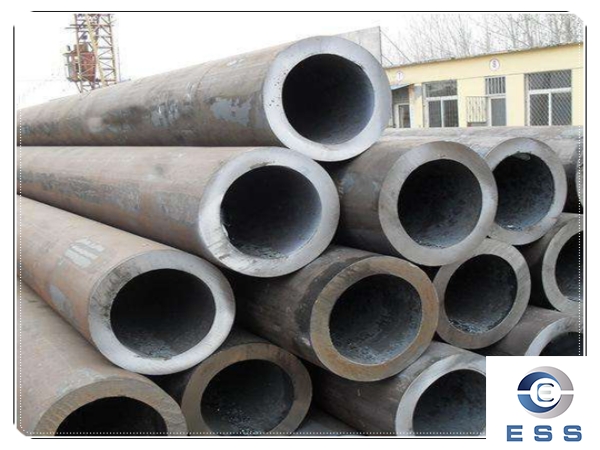What is seamless pipe?

Seamless steel pipe has a hollow cross-section and is widely used as a pipeline for conveying fluids, such as oil, natural gas, coal gas, water and some solid materials. Compared with solid steel such as round steel, steel pipe is lighter in weight under the same bending and torsional strength. It is an economical cross-section steel and is widely used in the manufacture of structural parts and mechanical parts, such as oil drill pipes, automobile transmission shafts, bicycles, etc. The use of steel pipes to make annular parts such as frames and steel scaffolding used in construction can improve material utilization, simplify manufacturing processes, save materials and processing time, such as rolling bearing rings, jack sleeves, etc., have been widely made of steel pipes.
The weight of seamless steel pipe depends on its length, diameter and wall thickness, and is usually calculated using the following formula:
Weight (kg) = (outer diameter-wall thickness) × wall thickness × length × 0.02466
Among them, 0.02466 is the density coefficient, which depends on the material of the steel pipe and is generally 7.85 (g/cm³).
Weight of common seamless steel pipes
The following are the weights of some common seamless steel pipes for reference only:
1. 2-inch SCH40 seamless steel pipe weighs about 3.64kg/m
2. 3-inch SCH40 seamless steel pipe weighs about 5.51kg/m
3. 4-inch SCH40 seamless steel pipe weighs about 7.46kg/m
4. 6-inch SCH40 seamless steel pipe weighs about 13.78kg/m
It should be noted that the weight of seamless steel pipes of different thicknesses and diameters will be different. The above data is only for reference of common specifications.
How to calculate the weight of seamless steel pipes based on pipe diameter and wall thickness
If you need to calculate the weight of seamless steel pipes of unconventional specifications or sizes, you can use the following methods:
1. Calculate the cross-sectional area based on the diameter and wall thickness, the formula is: (outer diameter-wall thickness) × wall thickness × π
2. Calculate the volume based on the calculated cross-sectional area and the length of the steel pipe, the formula is: cross-sectional area × length
3. Calculate the weight of the steel pipe based on the volume and density coefficient of the steel pipe, the formula is: volume × density coefficient
Factors affecting the weight of seamless steel pipes
In addition to length, diameter and wall thickness, the weight of seamless steel pipes is also affected by the following factors:
1. Material
Different steels have different densities, and the weight of steel pipes of the same specifications is also different.
2. Non-standard specifications
The weight of non-standard steel pipes is difficult to determine.
3. Surface treatment
Different surface treatments will also affect the weight of seamless steel pipes. For example, coating treatments such as painting or galvanizing will increase the weight of the pipe, while cold galvanizing will not.
4. Pipe diameter
The pipe diameter is one of the main factors affecting the weight of seamless steel pipes. Generally speaking, the larger the diameter, the heavier the seamless steel pipe. According to industrial standards, seamless steel pipes with larger diameters are more suitable for conveying large amounts of gas, fluid and solid materials.
5. Wall thickness
Wall thickness is also an important factor affecting the weight of seamless steel pipes. Compared with the diameter, the wall thickness has a more obvious effect on the weight of seamless steel pipes. For seamless steel pipes of the same diameter, the thicker the wall, the heavier the weight.
6. Alloy elements
The alloy elements in seamless steel pipes also have a certain effect on the weight of the pipe. Adding alloy elements such as chromium and nickel can improve the hardness and corrosion resistance of seamless steel pipes, but it will also increase the weight of the pipe.
7. Length
The length of the steel pipe will also affect its total weight. For steel pipes of the same diameter and wall thickness, the longer the length, the greater the total weight.
8. Allowable deviation
During the manufacturing process, the outer diameter and wall thickness of the steel pipe may have a certain allowable deviation, which will indirectly affect the weight of the steel pipe.
9. Production process
Different production processes such as cold rolling or cold drawing may result in slight differences in the weight of the steel pipe.
In summary, the weight of a seamless steel pipe depends on its length, diameter and wall thickness, and its weight can be calculated using a formula or calculator. It is necessary to select the appropriate seamless steel pipe specifications and materials according to the specific situation to achieve the best use effect.
Read more: Seamless Steel Pipe Sizes













 Eastern Steel Manufacturing Co.,Ltd not only improve product production and sales services, but also provide additional value-added services. As long as you need, we can complete your specific needs together.
Eastern Steel Manufacturing Co.,Ltd not only improve product production and sales services, but also provide additional value-added services. As long as you need, we can complete your specific needs together.










